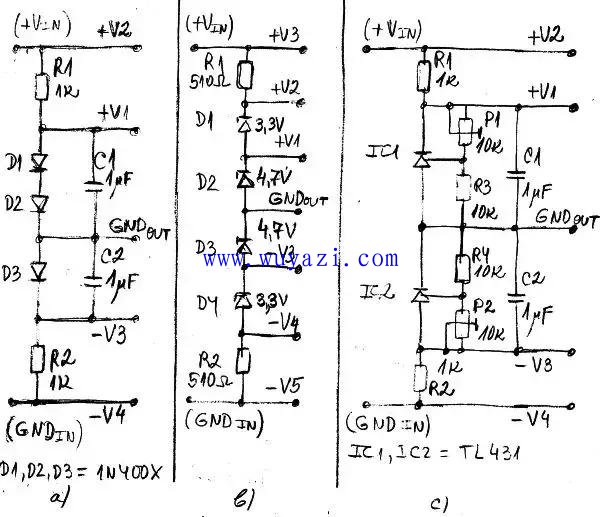In many electronic applications, it's necessary to obtain several milliamps of current from two or more low-voltage power supplies or DC sources. In such cases, the power management doesn't need to be overly strict, making simple and cost-effective Solutions ideal. One such approach is using voltage dividers based on diodes, Zener diodes, and shunt regulators.
Modern Zener diodes are available with power ratings ranging from 0.3W to 1.3W and offer a reference voltage tolerance of ±2% or better. These components can be effectively used in basic voltage divider circuits. Figure 2 presents three examples of such configurations.

Figure 2: Voltage divider using diodes and Zener diodes.
a) A voltage divider using a standard diode.
b) A voltage divider using a Zener diode.
c) A voltage divider using two shunt regulators (TL431).
In Figure 2a, a simple voltage divider is constructed using diodes. By connecting multiple diodes or LEDs in series, they can function as shunt regulators. In this example, two diodes D1 and D2 generate a positive output voltage +V1, while another diode D3 produces a negative output voltage -V3. The ground point GNDout can be placed anywhere between the diodes, offering flexibility in design.
Figure 2b illustrates a similar setup using Zener diodes. Multiple Zener diodes can be connected in series to create both positive and negative output voltages. Here, D1 and D2 produce +V1 and +V2, while D3 and D4 provide -V3 and -V4. The output ground GNDout is positioned between D2 and D3. Zener diodes can be of the same or different types, allowing for various voltage combinations.
Instead of relying solely on diodes or Zener diodes, we can use an adjustable shunt regulator like the TL431. This component offers greater flexibility, as the output voltage can be fine-tuned using resistors, trimmer potentiometers, or other variable components.
Figure 2c shows a voltage divider built around a TL431 shunt regulator. In this configuration, two TL431s or LM341s are used to generate both a positive output voltage +V1 and a negative output voltage -V3. The positive voltage can be adjusted using a trimmer potentiometer P1, while P2 controls the negative output. This makes the circuit highly adaptable for different applications.
By connecting multiple shunt regulators in series, as seen in Figures 2a and 2b, you can create more complex voltage division schemes. These regulators essentially act as adjustable Zener diodes, providing stability and precision in low-power applications. Whether using passive components or active regulators, these voltage dividers offer a practical solution for generating multiple voltage levels from a single supply.
Fiber Optic Enclosure,Corning Fiber Optic Enclosure,Fiber Optic Enclosure Box,Plastic Fiber Optic Enclosure
Huizhou Fibercan Industrial Co.Ltd , https://www.fibercan-network.com